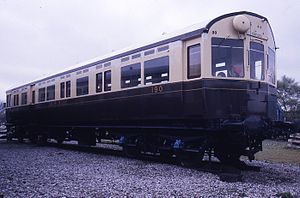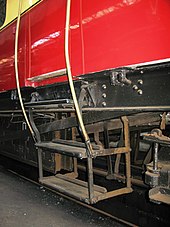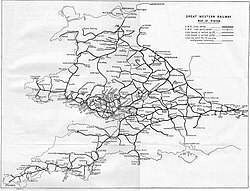GWR autocoach
This article needs additional citations for verification. (October 2014) |
| GWR autocoach | |
|---|---|
 Autocoach 190 preserved at Didcot Railway Centre | |
| In service | 1904–1964 |
| Manufacturer | Swindon Works |
| Constructed | 1904–1954 |
| Number built | 256 |
| Number preserved | 15 |
| Number scrapped | 241 |
| Diagram | A – Z, A1 – A44 |
| Fleet numbers | 1 – 256 |
| Operators | |
| Specifications | |
| Track gauge | 4 ft 8+1⁄2 in (1,435 mm) |
The GWR autocoach (or auto-trailer) is a type of coach that was used by the Great Western Railway for push-pull trains powered by a steam locomotive. The distinguishing design feature of an autocoach is the driving cab at one end, allowing the driver to control the train without needing to be located in the cab of the steam locomotive. This eliminates the need to run the engine round to the other end of the coach at the end of each journey.
When one or more autocoaches are connected to a suitably equipped steam locomotive, the combination is known as an autotrain, or, historically, a railmotor train. A steam locomotive provided with the equipment to be used as an autotrain is said to be auto-fitted.
The autocoach is the forerunner of the driving trailer used with push–pull trains.
Design features[edit]

A locomotive fitted with additional control equipment is used to power the autotrain. When running 'autocoach first', the regulator is operated by a linkage to a rotating shaft running the length of the locomotive, passing below the cab floor. This engages (via a telescopic coupling) with another shaft running the full length below the floor of the autocoach. This shaft is turned by a second regulator lever in the cab of the autocoach. (See photograph sequence below.) The driver can operate the regulator, brakes and whistle from the far (cab) end of the autocoach; the fireman remains on the locomotive and (in addition to firing) also controls the valve gear settings. The driver can also warn of the train's approach using a large mechanical gong, prominently mounted high on the cab end of the autocoach, which is operated by stamping on a pedal on the floor of the cab. The driver, guard and fireman communicate with each other by an electric bell system.[1]
-
The lever above the cab window moves a vertical rod...
-
...which rotates the long rod beneath the coach...
-
...to turn the flat bar at the back of the coach...
-
...that engages with the socket on the locomotive to operate the regulator.
In operation[edit]

If more than one autocoach was used, the locomotive would usually be marshalled between the coaches, as 'play' in the control linkages could otherwise make operation difficult. This arrangement was not always possible where turntables were not convenient for turning coaches and hence up to two autocoaches could follow or lead a locomotive with cab ends away from the locomotive.[2]
Many GWR suburban services around Plymouth were formed of fixed autotrain formations of four autocoaches, two each side of the locomotive with cabs leading in each direction. When these were introduced in 1906, experiments were made to harmonise the appearance of the locomotive in the middle of the train by cutting down the side tanks and encasing the entire locomotive in a square bodyshell of the same basic design, height and width as the coaches, complete with 'windows' and the same chocolate/cream paint livery. Two 2021 Class and two 517 Class engines were modified in this way.[3][4]
Accidents and incidents[edit]
- On 15 April 1923, carriage No. 70 formed a passenger train hauled by locomotive No. 215. The train was in a head-on collision with a freight train at Curry Rivel, Somerset due to a signalman's error. Nine people were injured.[5]
- On 16 November 1937, an empty train in a siding at the eastern end of Ealing Broadway station (between platforms 2 and 3) was waiting to be called into the platform to form the next service to Denham when the driver started the train in thick fog without noticing either that the points were not set for the platform nor that the signals were against him, and the auto-trailer crashed into the signal box. This auto-trailer, no. 211 of Diagram A31, had been converted in August 1935 from steam rail motor no. 81 (Diagram Q1); it was repaired after the accident, and was not withdrawn until March 1959.[6][7][8][9][10]
Fleet list[edit]
| Year | Diagram | Lot no. | Fleet no. | Length | Notes | Preserved examples |
|---|---|---|---|---|---|---|
| 1904 | A[12] | 1055 | 1 | 59 ft 6 in (18.14 m) | ||
| 1904 | B[13] | 1055 | 2 | 70 ft 0+3⁄4 in (21.36 m) | ||
| 1905 | B, V, W, X, A4[13][14] | 1081 | 3–6 | 70 ft 0 in (21.34 m) | ||
| 1905 | C[15][14] | 1087 | 7, 8 | 59 ft 6 in (18.14 m) | ||
| 1905 | D, A11, A12[16] | 1090 | 9, 10 | 70 ft 0 in (21.34 m) | ||
| 1905 | E, F[17][14] | 1097 | 11–13 | 70 ft 0 in (21.34 m) | ||
| 1905 | G, G1, H[18][14] | 1097 | 14–17 | 52 ft 0+3⁄4 in (15.87 m) | ||
| 1906 | J, J1[19][14] | 1102 | 19–24 | 59 ft 6 in (18.14 m) | ||
| 1905 | K, K1, Y, A5[20][14] | 1103 | 25–28 | 70 ft 0 in (21.34 m) | ||
| 1906 | L[21][14][22] | 1108 | 29–34 | 70 ft 0 in (21.34 m) | ||
| 1906 | M, M1, A8[23] | 1108 | 18, 35 | 54 ft 0+3⁄4 in (16.48 m) | ||
| 1907 | N[24] | 1126 | 36–41 | 59 ft 6 in (18.14 m) | 38 at the Telford Steam Railway | |
| 1906 | L[22] | 1127 | 42–47 | 70 ft 0 in (21.34 m) | ||
| 1907 | O, S[25][22] | 1128 | 48 | 70 ft 0 in (21.34 m) | Experimental | |
| 1907 | P[26] | 1130 | 49–52 | 70 ft 0 in (21.34 m) | ||
| 1908 | L[22] | 1141 | 53–58 | 70 ft 0 in (21.34 m) | ||
| 1908 | L[22] | 1143 | 59–70 | 70 ft 0 in (21.34 m) | ||
| 1909 | Q[27][22][28] | 1160 | 71, 72 | 70 ft 0 in (21.34 m) | ||
| 1909 | R[27][22][28] | 1161 | 73, 74 | 70 ft 0 in (21.34 m) | ||
| 1911 | T[29][22] | 1190 | 75–80 | 70 ft 0 in (21.34 m) | ||
| 1912 | U[29][28] | 1198 | 81–92 | 70 ft 0 in (21.34 m) | 92 at Didcot Railway Centre, used with the steam railmotor | |
| 1913 | Q[28] | 1224 | 93–95 | 70 ft 0 in (21.34 m) | ||
| 1913 | R[28] | 1225 | 96–98 | 70 ft 0 in (21.34 m) | ||
| 1915 | Z | — | 99–104 | 59 ft 6 in (18.14 m) | Rebuilt from railmotors 3–8 | |
| 1917 | A6 | — | 105, 106 | 57 ft 0+3⁄4 in (17.39 m) | Rebuilt from railmotors 1, 2 | |
| 1916–19 | A7 | — | 107–112 | 59 ft 6 in (18.14 m) | Rebuilt from railmotors 9–14 | |
| 1919–20 | A9 | — | 113–124 | 59 ft 6 in (18.14 m) | Rebuilt from railmotors 17–28 | |
| 1920–23 | A10 | — | 125, 128–133 | 59 ft 6 in (18.14 m) | Rebuilt from railmotors 29, 32, 31, 33–36 | |
| 1920 | A13 | — | 126 | 70 ft 0 in (21.34 m) | Rebuilt from railmotor 59 | |
| 1920 | A14 | — | 127 | 70 ft 0 in (21.34 m) | Rebuilt from railmotor 60 | |
| 1923 | A15 | — | 136, 137 | 70 ft 0 in (21.34 m) | Rebuilt from railmotor 46, 47 | |
| 1923 | A17 | — | 134 | 70 ft 0 in (21.34 m) | Rebuilt from railmotor 43 | |
| 1923 | A18 | — | 135 | 70 ft 0 in (21.34 m) | Rebuilt from railmotor 44 | |
| 1923 | A19 | — | 138–140 | 70 ft 0 in (21.34 m) | Rebuilt from railmotors 50–52 | |
| 1928 | A23 | — | 146 | 70 ft 0 in (21.34 m) | Rebuilt from railmotor 38 | |
| 1928 | A24 | — | 147 | 59 ft 6 in (18.14 m) | Rebuilt from railmotor 41 | |
| 1928 | A25 | — | 148 | 70 ft 0 in (21.34 m) | Rebuilt from railmotor 45 | |
| 1928 | A26 | — | 149 | 70 ft 0 in (21.34 m) | Rebuilt from railmotor 57 | |
| 1928 | A29 | — | 150–153 | 70 ft 0 in (21.34 m) | Rebuilt from railmotors 61, 63, 67, 68 | |
| 1928 | A26 | — | 154–157 | 70 ft 0 in (21.34 m) | Rebuilt from railmotor 85, 87, 89, 90 | |
| 1928 | A26 | — | 158 | 70 ft 0 in (21.34 m) | Rebuilt from railmotor 99 | |
| 1929 | A27[30] | 1394 | 159–170 | 59 ft 6 in (18.14 m) | 163 at the South Devon Railway 167 at the Chinnor & Princes Risborough Railway 169 at the West Somerset Railway | |
| 1930 | A28[30] | 1410 | 171–180 | 62 ft 8 in (19.10 m) | 174 at the Llangollen Railway 178 at the Severn Valley Railway | |
| 1930 | A26[30] | 1432 | 181–185 | 70 ft 0 in (21.34 m) | Rebuilt from railmotors 54, 56, 84, 95, 94 | |
| 1930 | A29[30] | 1432 | 186 | 70 ft 0 in (21.34 m) | Rebuilt from railmotor 62 | |
| 1933 | A33[31] | 1480 | 187–196 | 62 ft 8 in (19.10 m) | 190 at the Didcot Railway Centre | |
| 1934 | A23[31] | 1511 | 197, 198 | 70 ft 0 in (21.34 m) | Rebuilt from railmotors 39, 40 | |
| 1934 | A26[31] | 1511 | 199, 200, 206 | 70 ft 0 in (21.34 m) | Rebuilt from railmotors 53, 58, 86 | |
| 1934 | A29[31] | 1511 | 201 | 70 ft 0 in (21.34 m) | Rebuilt from railmotor 69 | |
| 1934 | A31[31] | 1511 | 202–205 | 59 ft 6 in (18.14 m) | Rebuilt from railmotors 73, 74, 82, 83 | |
| 1935 | A31[31] | 1521 | 207–209 | 59 ft 6 in (18.14 m) | Rebuilt from railmotors 75, 78, 79 | |
| 1936 | A26[31] | 1542 | 210, 212–215 | 70 ft 0 in (21.34 m) | Rebuilt from railmotors 91, 93, 96–98 | 212 restored as a steam railmotor at the Didcot Railway Centre |
| 1936 | A31[31] | 1542 | 211 | 59 ft 6 in (18.14 m) | Rebuilt from railmotor 81 | |
| 1936 | A29[31] | 1545 | 216–218 | 70 ft 0 in (21.34 m) | Rebuilt from railmotors 64, 66, 72 | |
| 1936 | A31[31] | 1542 | 219 | 59 ft 6 in (18.14 m) | Rebuilt from railmotor 76 | |
| 1938 | A34[31] | 1600 | 1668–1671 | 57 ft 0 in (17.37 m) | Auto-fitted Brake Thirds | |
| 1951 | A38[30] | 1736 | 222–234 | 64 ft 0 in (19.51 m) | 232 was modified as a first class saloon on the Dartmouth Steam Railway 233 was modified as a test coach by British Rail (see below) |
225, 228 and 233 at the South Devon Railway 231 at the Didcot Railway Centre 232 at the Bodmin and Wenford Railway |
| 1951 | A39[31] | 1736 | 220 | 64 ft 0 in (19.51 m) | ||
| 1951 | A40[31] | 1736 | 221 | 64 ft 0 in (19.51 m) | ||
| 1953 | A43[31] | 1766 | 235–244 | 64 ft 0 in (19.51 m) | 238 Chaffinch on the Severn Valley Railway 240 on the South Devon Railway | |
| 1953 | A44 | — | 245–256 | Rebuilt from Brake Thirds 5491/95, 4015/16/05/19, 4343, 5871, 4358, 5875, 4351/45 |
Auto-fitted locomotives[edit]
Several Great Western locomotive classes included examples equipped to work in autotrains at different times. These included:
| Type | Total auto-fitted | Introduced | Preserved examples | Comments |
|---|---|---|---|---|
| 455 Class 2-4-0T | About 40 | 1869 | – | Some fitted with auto gear after 1905[32] |
| 517 Class 0-4-2T | 86 | 1868 | – | Some fitted with auto gear after 1905[32] |
| 645 Class 0-6-0PT | 1 | 1872 | - | No. 1522 fitted in April 1931; withdrawn November 1937[33][34] |
| 1076 Class 0-6-0ST/PT | 21 | 1870 | – | Some fitted with auto gear after 1905[32] |
| 1854 Class 0-6-0PT | 1 | 1890 | - | No. 1728 auto-fitted at some point in the 1920s; withdrawn February 1932[33][35] |
| 2021 Class 0-6-0ST/PT | 27 | 1897 | - | Some fitted with auto gear after 1905[32] |
| 4575 Class 2-6-2T | 15 | 1927 | 5572 | Certain locomotives of this class fitted with auto gear in 1953[32] |
| 4800 Class 0-4-2T | 75 | 1932 | 1420, 1442, 1450, 1466 | Auto-fitted version of 5800 Class later renumbered as 1400 Class[32] |
| 5400 Class 0-6-0PT | 25 | 1930 | – | All auto-fitted[32] |
| 6400 Class 0-6-0PT | 40 | 1932 | 6412, 6430, 6435 | Smaller wheel version of 5400 Class, all auto-fitted[32] |
References[edit]
- ^ Lewis, John (1991). Great Western Auto Trailers - Part One: Pre-Grouping Vehicles. Didcot: Wild Swan. pp. 11–13. ISBN 0-906867-99-1.
- ^ Kingdom, Anthony R; Lang, Mike (2004). The Newton Abbot to Moretonhampstead Railway. ARK Publications (Railways). pp. 32, 43, 62. ISBN 1-873029-09-8.
- ^ Beck, Keith; Copsey, John (1990). The Great Western in South Devon. Didcot: Wild Swan Publications. pp. 184–186. ISBN 0-906867-90-8.
- ^ Lewis 1991, pp. 34–35
- ^ Vaughan, Adrian (1989). Obstruction Danger. Wellingborough: Patrick Stephens Limited. pp. 29–32. ISBN 1-85260-055-1.
- ^ Trevena, Arthur (1980). Trains in Trouble. Vol. 1. Redruth: Atlantic Books. p. 41. ISBN 0-906899-01-X.
- ^ Lewis 1991, pp. 197–200
- ^ Lewis, John (1995). Great Western Auto Trailers - Part Two: Post-Grouping and Absorbed Vehicles. Didcot: Wild Swan. p. 312. ISBN 1-874103-25-9.
- ^ Mitchell, Victor E.; Smith, Keith (April 2000). Ealing to Slough. Western Main Lines. Midhurst: Middleton Press. map IV, figs. 9, 10. ISBN 1-901706-42-7.
- ^ "Accident at Ealing Broadway on 16th November 1937". The Railways Archive. Retrieved 29 October 2014.
- ^ Harris 1966, pp. 131–156.
- ^ Lewis 1991, pp. 51–52
- ^ a b Lewis 1991, pp. 53–64
- ^ a b c d e f g Harris, Michael (1966). Great Western Coaches: 1890–1954. Newton Abbot: David and Charles. p. 146.
- ^ Lewis 1991, pp. 111–114
- ^ Lewis 1991, pp. 65–66
- ^ Lewis 1991, pp. 67–70
- ^ Lewis 1991, pp. 124–126
- ^ Lewis 1991, pp. 115–118
- ^ Lewis 1991, pp. 71–72
- ^ Lewis 1991, pp. 75–87
- ^ a b c d e f g h Harris 1966, p. 147
- ^ Lewis 1991, pp. 127–128
- ^ Lewis 1991, pp. 119–122
- ^ Lewis 1991, pp. 87–91
- ^ Lewis 1991, pp. 91–92
- ^ a b Lewis 1991, pp. 93–110
- ^ a b c d e Harris 1966, p. 148
- ^ a b Lewis 1991, pp. 97–64
- ^ a b c d e Harris 1966, pp. 151–152
- ^ a b c d e f g h i j k l m n Harris 1966, pp. 153–156
- ^ a b c d e f g h Veal, Colin; Goodman, John (1981). Auto-Trains and Steam Rail Motors of the Great Western. Didcot: Great Western Society. ISBN 0-902956-06-X.
- ^ a b Maidment, David (2019). Great Western Panniers. Pen & Sword Books Limited. ISBN 978-1-52673-451-8.
- ^ le Fleming, H. M. (April 1958). White, D. E. (ed.). The Locomotives of the Great Western Railway, part five: Six-coupled Tank Engines. RCTS. pp. E37, E39. ISBN 0-901115-35-5. OCLC 500544510.
- ^ le Fleming 1958, pp. E64, E66.
Further reading[edit]
- Lewis, John (2004). Great Western Steam Railmotors: and their services. Wild Swan Publications. ISBN 1-874103-96-8.
- "GW Autocoach 163 – History and Specifications". 163Autocoach.co.uk. GWR Autocoach 163 Trust. Archived from the original on 2 September 2011.
External links[edit]
- West Somerset Railway – Photo gallery: Restoration of autocoach no 169 – includes many pictures of the innards of an autocoach





